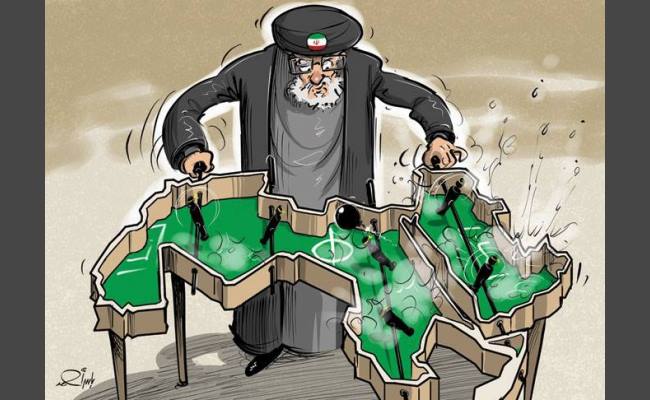Iran’s leaders to blame for currency crisis
إيران هي المسؤولة عن الأزمة الحالية
Dr. Majid Rafizadeh/Arab News/April 24/18
Iran’s ruling mullahs continue to view other countries, specifically the United States, as threats to their hold on power and the expansion of their influence in the region. Nevertheless, recent developments indicate that the major threat to the Iranian regime is actually surfacing from within the country thanks to the underlying currency and economic crises.
Imagine the value of your money decreasing by almost half in the matter of a few days, and it continuing to plummet while the economy in the rest of the world is booming. That is exactly what is occurring across Iran.
Iran’s national currency, the rial, has dropped to historic lows — one US dollar, which equaled approximately 35,000 rials in November last year, now buys you nearly 62,000. Amid the crisis, Iranian officials announced that they have switched from dollars to euros for foreign trades and transactions.
In such a situation, Iranian people have panicked and many have rushed to banks to withdraw their money in order to convert it to a more stable currency, specifically the dollar. Such a sharp devaluation of the currency makes the financial situation of ordinary people much more severe and strenuous.
This issue is particularly critical because, a few months ago, many people took to the streets protesting the high prices and economic austerity they faced on a daily basis. If the underlying problem continues, this could lead to another nationwide protest. The difference is that, this time, the regime may not be capable of crushing and subduing the demonstrations.
But the Iranian regime appears not to have taken any concrete steps toward addressing the people’s grievances. The reaction to people’s panic and difficulties regarding the recent currency devaluation has been trivial or indifferent. Some Iranian officials use their classic tactic of blaming other countries, specifically the US, for the crisis, while some call it a foreign “conspiracy.” Iran’s Supreme
Leader Ali Khamenei pointed out that “foreign enemies” are behind the “recent issues in the currency market.” He urged Etela’at (Iran’s ministry of intelligence) to foil the plot.
The Iranian regime’s financial corruption, misuse of public funds, and the widespread banking crisis are among the major reasons behind the present currency and economic crises.
However, the truth is that the Iranian leaders ought to point fingers at themselves for the crisis, as the rest of the world plays no role in Tehran’s rial crisis. In fact, one should remember that the US and other members of the P5+1 helped Tehran by lifting all four rounds of the United Nations’ economic sanctions against the regime three years ago.
Iran’s oil exports and trade with European countries have brought Tehran billions of dollars of extra revenues. The regime has come out of economic isolation. This begs the question, what are the reasons are behind the currency and economic crises?
A few months ago, an investor asked me if investing in Iran’s currency was a good move as Tehran was reentering the global market. I replied negatively due to the following reasons, which will also likely continue to contribute to the devaluation of Iran’s currency.
The first reason is financial corruption at the top and across the political spectrum, among both moderates and hardliners. Iran’s President Hassan Rouhani famously promised that he would root out “corruption in the country’s administrative and economic system.” But misuse of public funds continues on a large scale and the currency has been devaluated much more since Rouhani took office in 2013.
Secondly, Iran’s revenues are being spent on keeping Bashar Assad in power, or supporting militia and terrorist groups across the region, rather than strengthening Iran’s economy and redistributing wealth.
The third factor is related to the banking system. The regime has developed a flawed system where banks are paying one of the highest interest rates in the world — as much as 20 percent on savings accounts. To compare, the average interest rate for US banks is 0.06 percent.
At first glance, Iran’s high interest rate may look appealing. But such a system is designed to help the officials and those at the top rather than the ordinary people. People who have connections and have accumulated wealth through corruption can deposit their billions in one of the banks, such as Caspian or Sepah, and receive 20 percent interest every year while doing nothing. On the other hand, people who mostly obtain loans to buy a car, a house or pay university tuition will be required to pay back nearly the same inflated and excessive interest on their loans.
The Iranian regime’s financial corruption, misuse of public funds, and the widespread banking crisis are among the major reasons behind the present currency and economic crises. In fact, these problems are systemic and exist deep in Tehran’s economic infrastructure. The recent currency crisis is not an anomaly or an exception. The rial has plummeted continuously for the last 39 years — since the establishment of the Islamic Republic — from nearly 70 rials a dollar in 1979 to approximately 62,000 in 2018. The negative trend will most likely continue as long as the Iranian regime is in power.






















